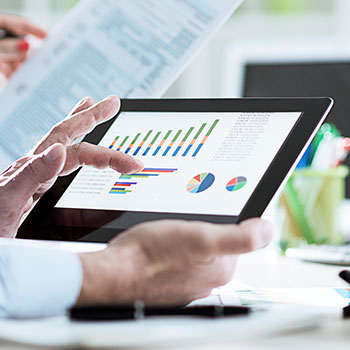The state of accounts payable today depends who you ask. Many are still stuck using manual processes, dealing with paper on a daily basis, and drowning under rising processing costs. Others have embraced the digital solutions available out there, using automation to drive efficiency, visibility, and cost savings.
As emerging technology advances, these solutions will incorporate new capability to deliver further benefits to accounts payable teams. And as the role of automation grows, how will the focus of the accounts payable department change?
This article looks at accounts payable today, and explores how it may transform in the future.
The biggest bugbear for 38% of AP departments is “too many paper documents”
ACAPP
The current state of accounts payable
The role of accounts payable departments has, ultimately, not changed drastically in the last decade. The purpose of the team is still to complete payments, control expenses, and process, verify and reconcile invoices. But the way in which this is done is beginning to shift.
Solutions have been available for many years that can help capture, automate and digitalise the process. Those who have embraced these solutions have seen real business benefits – from cost savings, to improved cash flow, and greater productivity. But many organisations are yet to delve into the world of accounts payable automation.
For the majority of accounts payable teams today, the invoicing process still contains some tasks that are manual and paper-based. This includes actions such as receiving invoices as PDF files and printing them out, going through reports line-by-line, and manually chasing approvals through the cycle. The accounts payable function is mainly operational – completing day-to-day tasks that need to be done in order to support the business. Problems are often dealt with on a reactive basis as and when they are identified. In short, accounts payable today remains relatively archaic at most organisations.
- Only 5% of organisations are using a fully automated accounts payable process.
- 56% of businesses experience cash flow forecasting problems due to accounts payable issues.
- 63% of organisations say that reducing their processing costs is a top priority.
19% of organisations have no automation in their accounts payable process, and only 5% use a full, end-to-end automated approach. Statistics show that organisations using automation are able to process invoices in as little as a matter of hours and save up to 90% on processing costs. They also reduce the need for manual data entry and the company’s reliance on paper.
All of this seems to make perfect business sense – so why aren’t more businesses embracing fully automated accounts payable solutions? There isn’t a single definitive answer to this. Some organisations believe their processes are so unique and complex that a digital solution cannot meet their requirements. Sometimes it’s down to time – accounts payable teams are so flat out in day-to-day operations that they simply do not have enough time to down tools and implement something new. Others perceive cost as a barrier, due to scepticism about whether automation software can provide adequate return on investment.
The reality is that with the right help, most organisations can overcome these hurdles and truly transform their accounts payable process. As we see with transformation efforts across other business functions, it is not an overnight process. But the sooner this is done, the better prepared the business will be for the future.
 AP Dashboard
AP Dashboard
The future of accounts payable
What will the accounts payable process look like in the future? We’re likely to see adoption of automated solutions increase as organisations continue their digital transformation efforts, and expand these into all areas of the business. The role of the accounts payable department – and the employees within it – is likely to change too.
Advances in technology
In accounts payable, one of the most powerful technologies to watch is artificial intelligence and machine learning (AI/ML). Artificial intelligence is developed to replicate a human’s ability to think and use logic. Machine learning is a subset of AI that learns and evolves over time, improving processes without any human interaction. AI/ML is already being used in some accounts payable solutions, but it is a nascent technology in general, and still has much, much more future potential.
Next, big data. With increased use of digital technology, the amount of data being received, processed and generated grows massively. Big data refers to datasets that are simply too large for humans to effectively analyse, and relies on AI/ML to do the leg work.
Finally, blockchain. This is a term often associated with Bitcoin and cryptocurrency, but the underlying technology can be applied in many ways. A blockchain is a decentralised, distributed ledger that records transactions and related data in multiple places at the same time. In doing so, it must be peer-to-peer approved and subsequently becomes unalterable, meaning that risk and fraud are greatly reduced, whilst being fully transparent and massively scalable.
The role of the accounts payable function
As technology plays a bigger part in the accounts payable function, the role of employees within the department will change. The accounts payable department of the future will be proactive and strategic, rather than reactive and operational.

Remote and hybrid working
Replacing manual, paper-based processes with a digital, automated solution means that the need to work from a central location is reduced. More accounts payable staff will be able to work remotely, more of the time, as digital solutions are implemented and the role of the function changes.
Our view of the near future
Picture the scene. The invoice process is almost completely zero-touch. AI/ML is used to automatically detect errors, make intelligent decisions on how to handle invoices, perform administrative tasks, and even provide suggestions on how to make workflows more efficient. What was a largely manual process has become automated and intelligent, moving invoices through the workflow efficiently and smoothly. Day-to-day operations are no longer a laborious, cumbersome process, leaving employees to focus on the bigger tasks. And invoice processing costs are greatly reduced through shorter cycle times and a reduced need for resource, which also frees up money to invest in innovative pursuits.
Accounts payable teams have unprecedented visibility into working capital. Using past performance data and predictive analytics, future actions and outcomes are accurately modelled and predicted. A holistic view of cash flow is available, allowing spending trends to be easily identified and enabling policies to be optimised.
Blockchain has helped reshape invoice processing. Shared access to information means that invoice scanning is no longer required and, as all authorised stakeholders can review the transaction, the need for reconciliations is removed. As blockchain guarantees the authenticity and accuracy of a record, there is no need to check that the invoice matches the purchase order. Favourable payment terms with suppliers are secured as blockchain-managed contracts enable timely, secure payments. And audits are less stressful as all historical transactions are permanently recorded, providing end-to-end visibility.
Increased visibility into the organisation’s financials and real-time reporting allows the accounts payable team to act proactively, spotting potential issues and challenges before they become significant problems. A projected dip in cash flow is forecast in three months’ time, so proactive decisions are made that free up cash, allowing the business to continue operating as normal.
Day-to-day operational tasks, such as data entry and chasing approvals, are streamlined and automated. Accounts payable staff spend the majority of their time on strategic efforts – data analysis, identifying growth opportunities and refining controls. The department acts in an advisory role to the business, demonstrating their value through accurate cash flow projections, proactive problem solving and driving business growth.
The accounts payable team has embraced remote working, aligned with company policy. A face-to-face team meeting occurs once a month, where all accounts payable staff come to the office for the day. Staff split the rest of their time between working at home and in the office, based on individual preferences.
Due to growth, a new accounts payable team member has been hired. Although they live 80 miles away from the office, the remote working policy in place makes it easy for them to complete their duties from wherever they need to be. The new employee travels to the office when they need to and spends the rest of their time working from home.
Start preparing for the future, today
The accounts payable departments who thrive in the future will be those who start their journey today. Below are 5 recommendations to help you get started.
1. Build new skillsets
As the focus of accounts payable teams evolves and changes, new skills will be required to accommodate new requirements. Key areas to consider include:
- Data analytics
- Business intelligence
- Data security
- Business partners and relationship management
2. Form business-wide relationships
Automation will allow much of the typical invoice process to be handled with minimal manual intervention from the accounts payable team. Building relationships with stakeholders throughout the business will be key to supporting them to act based on accounts payable data.
3. Focus on cash flow
Automated reporting and insights will help accounts payable to get a holistic view of cash flow throughout the business. Focusing on this will help deliver maximum value to the organisation by optimising costs and creating opportunities for growth.
4. Embrace the technology available today
The technology to streamline the accounts payable process exists today. Many organisations still rely on manual, paper-based processes when they simply don’t need to. By taking new tech on board, accounts payable teams will see immediate improvements in efficiency, visibility, accuracy, and cost control. They will also be better prepared to deliver value to the business and withstand any potential disruption.
5. Bring in experts
Going through transformation alone can feel daunting, but it doesn’t have to be. Bringing in a partner to support you through the journey is a great way to ensure that you get from A to B (and to C, D, E…) successfully. You’ll get experts that work with you to ensure requirements are met, deploy the solution with as little disruption to daily operations as possible, and maximise the business benefits of the technology being implemented.
Summary
It’s not always easy to predict the future. But looking at the shifts occurring today, accounts payable is going to change significantly in the next few years. Technology evolution, the rise of remote/hybrid working, and the need for accounts payable to fulfil a more advisory role are all indicators of this. As with any change or disruption, it’s always better to be prepared. By embracing the technology available today and building new skills to achieve new goals, accounts payable teams can look towards the future with confidence and optimism.




